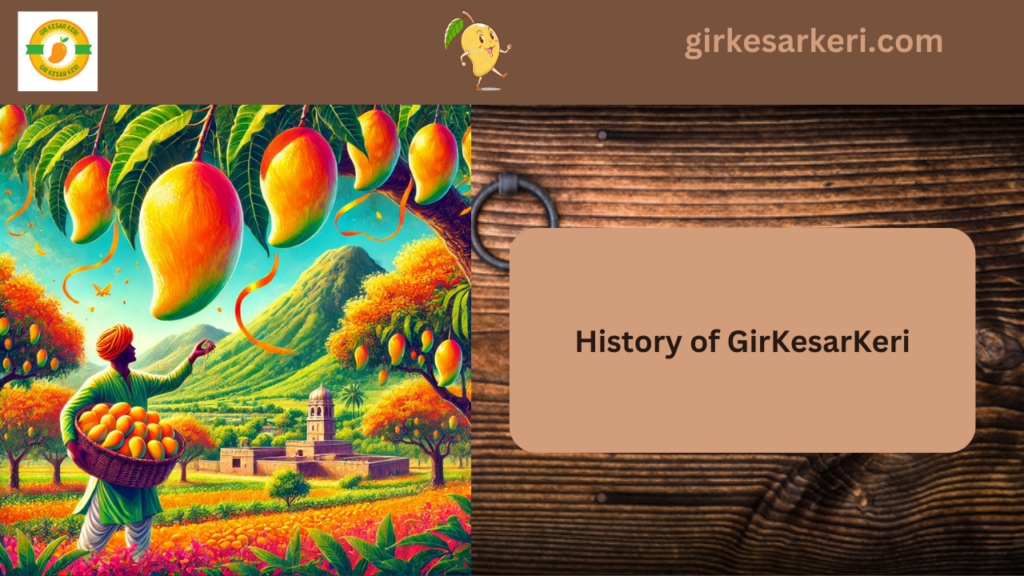Explore the Remarkable History of Gujarat’s Gir Kesar Keri
Introduction

Mangoes are often hailed as the “king of fruits,” and in India, they hold a special place in both our hearts and plates. Among the countless varieties of mangoes grown across the country, Gir Kesar Keri, or Kesar Mango, stands out as a gem. Sweet, fragrant, and packed with a saffron-like hue, this mango is a true delight for the senses. But have you ever wondered about its rich history? Let’s peel back the layers and explore the story behind this famous mango from Gujarat.
The Origin of Gir Kesar Keri
The journey of Gir Kesar Keri begins in the picturesque Gir region of Gujarat, India. This mango’s story dates back to the early 20th century when it was first cultivated in the foothills of the Girnar mountains. According to historical anecdotes, it was initially planted in the lush orchards of Junagadh, a region renowned for its fertile soil and favorable climate.
One charming tale involves the Nawab of Junagadh, who is said to have promoted the cultivation of this mango. He believed that the region’s unique combination of climate, soil, and proximity to the Gir forest made it the perfect home for a truly remarkable fruit. Over the years, the Gir Kesar mango grew in popularity, thanks to its exceptional flavor and vibrant saffron hue.
How Did Gir Kesar Keri Get Its Name?
Why is it called “Kesar”? The answer lies in its mesmerizing saffron-like color and aroma. The word “Kesar” translates to saffron in Hindi, and people named this mango after the luxurious spice due to its resemblance. When you slice open a perfectly ripened Gir Kesar mango, the rich orange-golden flesh is reminiscent of saffron threads.
This name also carries cultural significance. Saffron is considered a symbol of purity and richness in Indian culture, and the Kesar mango’s unparalleled taste and fragrance embody these qualities. The mango’s distinct identity reflects not just its unique traits but also its deep connection to Gujarat’s agricultural heritage.
Cultural and History Importance
The Gir Kesar Keri is more than just a fruit; it’s a cultural icon in Gujarat. Mangoes have always played a central role in Indian festivities and rituals, and Gir Kesar is no exception. From traditional feasts to offerings at temples, this mango has been an integral part of Gujarat’s traditions.
Local legends often celebrate the mango’s sweetness and allure. Farmers take immense pride in growing Gir Kesar mangoes, considering it not just a crop but a legacy. Over the years, it has also become a symbol of Gujarat’s prosperity and a key export that showcases the state’s agricultural prowess.
Geographical and Environmental Factors
What makes Gir Kesar mango so special? The answer lies in the unique geography of the Gir region. The soil here is rich in minerals, and the climate—with warm days and cool nights—creates the perfect conditions for mango cultivation. Additionally, the region’s proximity to the Gir forest ensures a balanced ecosystem that benefits the fruit’s growth.
This natural harmony imbues the mango with its signature taste and texture. Unlike other mango varieties, Gir Kesar Keri thrives in this specific environment, making it truly one of a kind. The region’s biodiversity also plays a vital role in sustaining its cultivation.
Recognition and Growth Over Time
Gir Kesar has journeyed from its humble beginnings in Junagadh to becoming one of India’s most famous mangoes. Authorities awarded it the prestigious GI (Geographical Indication) tag in 2011, officially recognizing its origin and uniqueness. This accolade not only protects its authenticity but also enhances its global reputation.
Exporters today send Gir Kesar mangoes worldwide, delighting mango lovers across continents. Their growing popularity has also encouraged farmers to adopt sustainable practices, ensuring that this treasure continues to thrive for generations.
Unique Characteristics of Gir Kesar Keri
What is the specialty of Gir Kesar mango? For starters, its vibrant orange hue and smooth, fiberless texture set it apart from other mangoes. The taste is a perfect balance of sweetness and acidity, while its rich aroma can transport you to a sunlit orchard in Gujarat.
Compared to other mango varieties like Alphonso, Gir Kesar Keri boasts a more robust flavor profile. People often call it the “queen of mangoes” for its exquisite quality. Enjoying this mango fresh or using it in desserts makes it a culinary delight.
Challenges in the History of Gir Kesar Keri
Like all great things, the journey of Gir Kesar mango hasn’t been without challenges. Farmers have faced issues like unpredictable weather patterns, pests, and diseases. Climate change has also impacted mango production, making it harder to maintain consistent yields.
However, the resilience of Gujarat’s farmers has ensured the survival of this iconic fruit. Through modern techniques and government support, efforts are being made to overcome these challenges and preserve the legacy of Gir Kesar Keri.
The Legacy and history of Gir Kesar Keri
Today, Gir Kesar mangoes are not just a source of pride for Gujarat but also a testament to India’s rich agricultural history. Their legacy lives on through the farmers who nurture them and the millions who savor their incredible flavor.
Modern initiatives, such as promoting sustainable farming and expanding global markets, are helping secure the future of this mango. As we enjoy a slice of Gir Kesar Keri, we also partake in a story that spans generations and celebrates the best of nature and human effort.
Conclusion
The history of Gir Kesar Keri is as vibrant and sweet as the mango itself. From its origins in the Gir region to its rise as a global sensation, it’s a story of tradition, resilience, and unmatched flavor. Next time you bite into a piece of this saffron-hued delight, take a moment to appreciate the journey it’s been on—a journey that connects you to the heart of Gujarat’s Saurashtra heritage.
So, what are you waiting for? Grab a Gir Kesar mango, savor its deliciousness, and share its incredible story with your loved ones!
